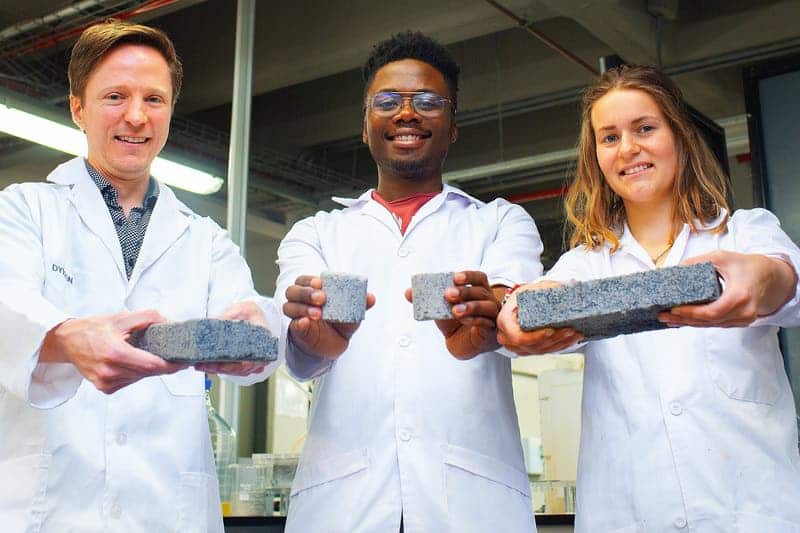University of Cape Town (UCT) researchers want to make cheaper fertilizers and greener buildings — using your toilet.

(From the left) UCT’s Department of Civil Engineering’s Dr Dyllon Randall and his students, Vukheta Mukhari and Suzanne Lambert, holding the newly-unveiled bio-brick.
Image credits University of Cape Town.
Building materials like concrete, steel, or bricks are quite energy-intensive to produce. Since most of this energy is produced in fossil-fuel plants, it has a sizeable carbon footprint. Emissions associated with fuel use and those released by certain chemical processes during manufacture add to these products’ overall carbon footprint.
But, if you’re looking for a more eco-friendly alternative for all your masonry pursuits…
Urine luck
A team led by Suzanne Lambert, a civil engineering master’s student at the UCT, unveiled the first bio-brick developed from human urine. The material is created through microbial carbonate precipitation, a process similar to that used by marine creatures to build their shells.
It largely involves strengthening sand with chemicals derived from urine. The sand is colonized with bacteria that produce urease (an enzyme that breaks down urea in urine. The resulting calcium carbonate binds the grains of sand together, creating a very solid object in virtually any shape. It has to be mentioned, however, that sand is becoming an increasingly scarce material.
The concept of using urea for bricks isn’t exactly new — it was first tested in the U.S. a few years ago. However, Lambert’s team is the first one to use human urine, not synthetic solutions, for the process. This isn’t the first bio-brick to be developed, nor the first solid brick based on simple materials — but they do come with a wide range of bonuses that make them stand out.
One of the best parts of the new bricks is that they’re fabricated in molds at room temperature. This drastically reduces their emission levels compared to regular bricks. The fabrication process can also be tweaked to address particular needs — lower production times (and thus, costs), or higher-strength.
If a client wanted a brick stronger than a 40 percent limestone brick, you would allow the bacteria to make the solid stronger by ‘growing’ it for longer,” said Dr. Dyllon Randall, a senior lecturer at UCT and Lambert’s supervisor. “The longer you allow the little bacteria to make the cement, the stronger the product is going to be. We can optimise that process.”
Brick the houses, sow the fields
Bio-bricks could also, surprisingly, help us grow plumper crops. Urine is rich in several chemical compounds that are key ingredients in fertilizers: nitrogen, potassium, and phosphorus (we’re running low on virtually every one of those compounds). Chemically speaking, Dr Randall adds, urine is liquid gold. Although it accounts for under 1% of domestic wastewater by volume, it provides 80% of the nitrogen, 63% of the potassium, and 56% of the phosphorus in wastewater. Nitrogen is particularly important from an agricultural point of view.
Most of these compounds can be harvested from wastewater, the team adds. Some 97% of the phosphorus present in urine, for example, can be recovered and used for fertilizers.
Virtually nothing is wasted when producing these bio-bricks, the team writes. The process starts with urine collected from novel fertilizer-producing urinals. Here, it’s used to create a solid fraction (which is basically a fertilizer mix). The liquid fraction is then used to grow the brick themselves.
“In that process, we’re only after two components: carbonate ions and the calcium. What we do last is take the remaining liquid product from the bio-brick process and make a second fertiliser,” Dr Randall explains.
The main hurdle the team has to overcome is logistics — namely the collection and transport of urine to processing facilities. How society reacts to the idea is another hotbed for discussion. Right now, the team is only dealing with urine collection from male urinals “because that’s socially accepted,” says Dr Randall. However, that leaves “half of the population” out of the process, which is a shame.
Still, Dr Randall hopes that their work will help people reconsider their relationship with waste — of any kind.
“In this example you take something that is considered a waste and make multiple products from it. You can use the same process for any waste stream. It’s about rethinking things,” he said.









